War will never cease until babies begin to come into the world with larger cerebrums and smaller adrenal glands.
Henry Louis Mencken (US Journalist).
The endocrine system of the body comprises a group of glands and organs that regulate and control various body functions by releasing specific proteins or steroids known as hormones. These are released into the bloodstream where they act as messengers, affecting the various activities of different parts of the body. When a particular hormone reaches its target cell it transmits its message by binding to a receptor, on the cell surface or in the cell nucleus, causing the cell to take a specific action. In this way, very small amounts of hormones can trigger very large responses in the body, controlling the function of entire organs, affecting such diverse processes as growth and development, reproduction, and sexual characteristics.
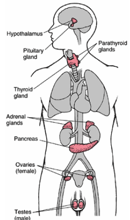
Although hormones circulate throughout the body, each type of hormone influences only certain organs and tissues. Some hormones affect only one or two organs, whereas others have influence throughout the body. The endocrine system comprises the hypothalamus, the pituitary gland, the thyroid gland, the parathyroid glands, the islets of the pancreas, the adrenal glands, the testes in men, and the ovaries in women. The secretion of each hormone must be regulated within precise limits, and so many endocrine glands are controlled by the interplay of hormonal signals between the hypothalamus, located in the brain, and the pituitary gland, which sits at the base of the brain.
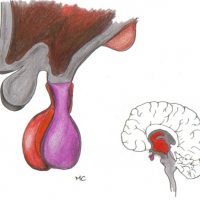
The hypothalamus is a region of the brain that secretes a number of hormones known as releasing hormones, as these further stimulate the secretion of hormones from the pituitary gland. For example, gonadotropin-releasing hormone released from the hypothalamus signals the pituitary to produce follicle stimulating hormone and leutenising hormone which, in turn, stimulates the ovaries or testes to produce yet further hormones, such as testosterone and oestrogen, to signal sexual development. An inherited deficiency of gonadotropin-releasing hormone, therefore, results in the absence or decreased function of testes or ovaries, and is known as Kallmann syndrome.
Two further hypothalamic hormones are vasopressin and oxytocin which are released through the pituitary. A major function of vasopressin is to maintain water balance by regulating levels of water excreted by the kidneys. A lack of vasopressin leads to large amounts of water being excreted by the kidneys – a condition known as diabetes insipidus.
The pituitary (Lat. pituita; mucus, as this gland was once thought to produce nasal mucus) gland is a pea-sized structure located at the base of the brain. It secretes several hormones including growth hormone, adrenocorticotropic hormone, follicle-stimulating hormone, luteinizing hormone, prolactin, melanocyte-stimulating hormone and endorphins that inhibit pain sensations and help control the immune system. Too much growth hormone occurring from early life or only in adulthood leads to gigantism and acromegaly, while growth hormone deficiency leads to proportional short stature. Too much prolactin, known as hyperprolactineamia, can trigger lactation and so is often associated with phantom pregnancy syndrome.
The thyroid gland is situated to the front of the neck and is named after an ancient Greek army shield, known as “thyreos”, which is shaped like a door with a notch at the top for the soldier’s chin. This gland secretes the hormone thyroxine that controls metabolism, respiration, and heart function. Mutations disrupting the function of thyroxine result in a disorder known as cretinism (though most cases of cretinism are the result of iodine deficiency) while an underactive thyroid gland present at birth, is known as congenital hypothyroidism while diseases such as Grave’s disease lead to increased hormone production, known as hyperthyroidism.
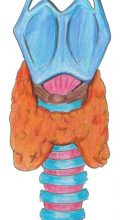
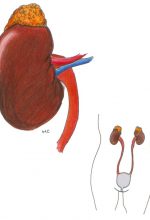
The pair of adrenal glands (Lat. ad; above, renes; kidneys) are located just above the kidneys. These secrete two steroids, aldosterone, which acts to conserve sodium ions and water in the body, and cortisol which increases blood glucose levels. They also secrete two hormones, epinephrine and norepinephrine, particularly during stress. When the adrenal glands become underactive Addison’s disease occurs, when they are overactive Cushing’s disease develops. Disruptions in the insulin hormone, produced by the pancreas lead to diabetes mellitus.
The testes control maleness is by producing male sex steroid hormones known as androgens (testosterone and dihydrotestosterone) that stimulate development of the male sex organs in addition to other male characteristics. Mutations in the androgen receptor lead to androgen insensitivity syndrome, while mutations in the gene for enzymes important for producing either dihydrotestosterone and oestrogen cause 5-alpha-reductase deficiency, aromatase deficiency or congenital adrenal hyperplasia.
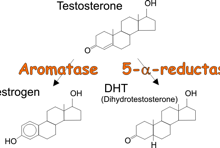
Gigantism
The pituitary constantly produces a regulated supply of growth hormone that, secreted into the bloodstream, stimulates cells of the body to grow and divide ensuring that all portions of the body grow at an equal rate. Increased production of growth hormone can occur as a result of a pitAuitary tumour. When this tumour develops during childhood a condition known as gigantism can occur characterised by lengthening bones, especially in the arms and legs, resulting in the individual growing to an unusually great height. Generally, a clinical definition of a giant is someone standing over 7ft 6in tall.
Perhaps the first written account of a true giant comes from the bible, as Goliath was said to stand “taller than six cubits” which equals about nine and a half feet. This may not be so farfetched because people afflicted with gigantism continue to grow throughout their lives.


One well-known individual with gigantism, called Charles Byrne, had an enlarged pituitary comparable in size to a peach. Growing to a height of 7ft 9in, he was constantly hounded by doctors desperate to get his body on their autopsy table. One particularly assiduous doctor, John Hunter, was particularly keen to boil his corpse the moment the poor man died in order to examine the skeleton. It was supposedly this that drove the poor man into drinking himself to death in 1783 at the age of 22. So afraid was he that John Hunter and the other doctors would get their hands on his body, Charles Byrne requested from his deathbed that he be buried at sea. However, John Hunter was quickly on the scene to bribe the hospital staff, purchasing the cadaver for 500 pounds. His skeleton still resides in the Royal College of Surgeons.
Kallmann Syndrome
An inherited deficiency of gonadotropin-releasing hormone, therefore, results in the absence or decreased function of testes or ovaries, and is known as Kallmann syndrome. First described in 1944 by the German geneticist, Franz Josef Kallmann, this syndrome generally presents with hypogonadism (i.e. an underproduction of testosterone), delayed puberty and a lack of secondary sex characteristics.
The American jazz and blues vocalist Jimmy Scott has an unusually high-pitched voice due to the effects of this syndrome preventing him from reaching puberty and so his voice never broke. The condition also stunted his growth at four feet eleven inches.

Diabetes Insipidus
A lack of vasopressin leads to large amounts of water being excreted by the kidneys; a condition known as central diabetes insipidus. Deriving from the Greek verb diabainein, which means to stand with legs apart, a person with diabetes insipidus can urinate as much as 18 litres daily – the average urine volume for a normal adult is 1.5 litres – which is naturally also accompanied by excessive thirst. The Latin word insipidus means without taste, referring to the diluted nature of the urine.
Not until 1792 was this genetic disorder was eventually described in the medical literature with the detailed the story of a French woman who drank over 20 litres of water a day. Since the age of 3 she had remembered drinking buckets of water, until, in her early teens, she was forced out of home by her uncompassionate, and probably bewildered, parents. This disease is usually caused by mutations in the gene for vasopressin that regulates levels of water excreted by the kidneys.


A far rarer form of diabetes insipidus results from mutations in a receptor for vasopressin found on the X chromosome and so leading to sex-linked inherited diabetes insipidus, specifically affecting males. This was long ago described in Scottish folklore where, according to legend, a gypsy woman travelling with her thirsty son was denied water by a housewife. The gypsy woman then cursed the housewife, causing the housewife’s sons to crave water while condemning her daughters to pass the curse on to future generations. And it appears that they did pass on the trait with two Scotsmen immigrating with the gene to Nova Scotia, Canada, in 1761 arriving on a ship named the Hopewell. As a result, this disease is relatively common in some regions of Canada. Considering that fresh water supplies on board ship would have been limited and carefully rationed, the journey for those two Scottish immigrants must have been a considerable ordeal.
Acromegaly
Acromegaly (Gr. acro; end, mega; large) occurs when too much growth hormone suddenly begins to be produced in adulthood, usually due to the development of a pituitary tumour, long after the growth plates of the bones have closed. This results in bones becoming deformed rather than elongated. Often, the jawbone can overgrow and cartilage in the voice box can thicken, making the voice deep and husky. A major complication is joint pain and arthritis with some individuals also feeling weaknesses in their limbs, loss of vision and severe headaches as the enlarging tissues compress nerves.
Film actors with this condition have inevitably been cast in intimidating roles such as Richard Kiel who played Jaws in the “James Bond” movies, and also Ted Cassidy and Carel Stryken who both played the character Lurch in “The Addams Family”. Rondo Hatton who played a number of thuggish parts during his movie career serves as an extreme example of how the disease can distort the skull and face.

Growth Hormone Deficiency
If the pituitary gland does not produce enough growth hormone in childhood, then an abnormally short stature may result, affecting all body parts to an equal degree.
The memoirs and life story of Count Josef Boruwlaski, who suffered from such a growth hormone deficit, reveals a great deal about the condition. Born in Russia in 1739 to parents of normal size, he grew no higher than 71cm. At the age of nine a wealthy noblewoman, Staorina de Caorliz, took a shine to Josef Boruwlaski and he went to live with her to be educated. As a result, although he only stood two feet tall in his early teens, he possessed perfect etiquette and was a brilliant composer of music, and as a result was accepted into the highest levels of society. One of Josef Boruwlaski’s four siblings also showed severe height restriction, while the other three grew to a normal stature, suggesting that as yet unidentified genetic mutations may well be behind the condition.


It is thought that similar mutations affect pygmy tribes (a term which is sometimes applied to communities in which the height of individuals does not exceed 150 cm). One such mutation found in the gene for growth hormone receptor occurs in a group of people living in the foothills of the Ecuadorian Andes. Interestingly, recent research shows this gene may not be indigenous as exactly the same gene mutation has been identified in a number of Israelis suggesting that the mutation may have been carried to the region by Spanish Jews immigrating in the early 1500s to escape persecution.
Growth hormone deficiency is is nowadays often treated with daily injections of growth hormone (a recombinant version of this hormone is produced by genetically engineered bactieria). Lionel Messi was diagnosed with growth hormone deficiency at the age of 11, with Barcelona offering, as part of his contract, to pay for Messi’s expensive medical bills if he was willing to move to Spain.

Hyperprolactineamia
Prolactin hormone is secreted in increased concentrations during pregnancy resulting in enlargement of the mammary glands and an increase in the production of milk. However, around 30% of pituitary tumours lead to increased prolactin production and increased lactation in women who are not pregnant. Accompanying the increased lactation is suppression of ovulation (prolactin inhibits ovulation to stop further pregnancies occurring during breastfeeding). Often women with this tumour visit their gynaecologist thinking that they might be pregnant.
This may have affected Queen Mary I of England, who died childless despite having symptoms suggestive of pregnancy on several occasions, including swelling breasts and discharges of milk.

Hypothyroidism
The majority of cases of hypothyroidism occur due to a lack of iodine in the diet during childhood. This is because the production of thyroid hormones requires iodine. This disease is also often referred to as cretinism, Crétin is an old French name for the wild men of the Alps in French folktales as this disease was for many centuries more common in areas where the soil is deficient in iodine – particularly in the Alpine regions of Europe. A survey in an area of Switzerland in 1810 revealed that among 70,000 inhabitants, 4,000 individuals suffered from cretinism.
A further sign of this disease is enlarged thyroids, known as goitres, as the thyroid attempts to make up for the hormone reduction. This used to be common in the Carboniferous Limestone area of Derbyshire where soils are naturally low in iodine, and for this reason the condition was often referred to at the time as “Derbyshire Neck”. This problem was eventually tackled with the introduction of iodised milk, generally produced by increasing the iodine content of animal feed.
An underactive thyroid gland resulting in thyroid hormone deficiency, when present at birth, is known as congenital hypothyroidism and affects approximately 1 in 4,000 newborn infants. Regarded as being the most prevalent inborn endocrine disorder it can result from mutations in a number of different genes involved in thyroid hormone synthesis. If not treated with daily doses of thyroid hormone, growth failure and permanent mental retardation can develop.

Hyperthyroidism
Hyperthyroidism, results in the release of excess thyroid hormones. This occurs in a number of diseases such as the autoimmune disorder Graves’ disease, resulting in weight loss (often accompanied by a ravenous appetite), fatigue, and a number of other symptoms.
The Olympic skier Janica Kostelic suffers from Graves’ disease. She first noticed something was wrong on a glacier in Switzerland, when she collapsed with breathing problems and had to be airlifted to hospital. After being diagnosed with hyperthyroidism, she had her thyroid removed at the beginning of 2005. She went on to win gold at the 2006 Winter Olympic Games in Turin – her fourth Olympic Gold medal – making her the most successful female skier in the history of the Olympic Games.

Addison's Disease
1:7,000-20,000
When the adrenal glands become underactive, Addison’s disease occurs. First described in 1855 by Thomas Addison, who committed suicide when his work was largely ignored and refused publication, this disease may be due to a genetic abnormality or else may result from an autoimmune reaction, whereby the body’s immune system attacks and destroys the adrenal tissue. A deficiency of aldosterone disrupts the kidneys ability to regulate water and salt balance leading to reduced blood pressure. In addition the inability to produce corticosteroids can lead to an extreme sensitivity to insulin so that the level of sugar in the blood may fall dangerously low. Weakness of muscles and the heart may also occur, and as a result the body may be unable to react properly under stress leading to possible severe medical complications. The pituitary gland, in an attempt to stimulate the adrenal glands, becomes more active leading to increased melanin production and darkened skin.
President John F. Kennedy was well cited sufferer of Addison’s disease and the suspected occurrence of the same disease in his sister, Eunice Kennedy Shriver, may argue for an inherited cause of his disease. At the age of 30, whilst in the UK, he was so ill that a doctor gave him less than a year to live and he was even given the last rites by the ship’s chaplain on his sea voyage home. Only 13 years later, when he ran for president, he appeared fit, healthy and tanned, and this no doubt influenced the voters. Ironically, his tan may well have been a side effect of his disease. The heavy amounts of steroids he had taken since childhood for his condition also resulted in osteoporosis and back pain which required him in addition to take cocktails of very strong pain medications. Many photographs from this time seem to show the swelling effects of the steroids, particularly in the face. The steroids could also have increased his libido, which may add weight to the many rumours surrounding JFK’s supposedly insatiable sex drive.


Another person thought to have suffered from Addison’s disease was Jane Austen who died in 1817 at the age of 42. Her last words of “Nothing, but death”, when asked by her sister Cassandra if there was anything she wanted, highlights the misery the disease could cause before the advent of modern-day treatment.
Cushing's Syndrome
Multiple different causes
1:200,000
Cushing’s syndrome occurs when the adrenal glands become overactive, often due to a benign tumour, producing high levels of steroids, which in turn control the amount and distribution of body fat. As a consequence, this syndrome results in excessive fat developing – a typical sufferer usually has a large, round face with arms and legs that are usually slender in proportion to the thickened trunk. In addition, these steroids also raise levels of testosterone which can lead to increased facial and body hair in women and balding in men.
It has been suggested that Henry VIII, the notably un-merry monarch, suffered from Cushing’s syndrome, which would have accounted for the bloated face seen in his portraits and the massive bulk of his body. The fact that this disorder can also cause irritability, depression, aggression, psychosis and impotence, might explain a few other things as well.

Androgen Insensitivity Syndrome
1:13,000
Mutations in the androgen receptor gene in a male results in the individual’s body being unable to react to the testosterone. This leads to a hermaphrodite appearance, primarily characterised by female characteristics but with testes that may be more or less evident. Referred to as androgen insensitivity syndrome, the condition can be so subtle that it may go unnoticed until after puberty; most individuals with the condition do not menstruate and hence are rendered infertile. People with AIS also tend to be taller, as the male Y chromosome is mainly responsible for growth, and slimmer due to the affect of the small amounts of oestrogen produced by the testes that in addition can stimulate generous breast growth. Also, due to low levels of androgens, girls with AIS will generally not suffer from acne and often present with beautifully clear skin, luxuriantly thick scalp hair and little or no pubic or underarm hair. The overall effect is that AIS women are often exceptionally beautiful and, as such, sufferers are often found in occupations such as modelling or acting.
A number of well-known women in history may well have suffered from AIS. It has been suggested that Queen Elizabeth I, known as the Virgin Queen, may have had the condition, but evidence is slim and seems mainly to derive from the fact that she never married and avoided sexual relations, this raised speculations that did not menstruate. Joan of Arc may well also have had the disorder and even during her life her gender raised speculation. An investigation following her execution in 1431, which received testimonies from over 100 witness statements, established that she had had well developed breasts, no pubic hair, and had never menstruated.


5-Alpha-Reductase Deficiency
Autosomal Recessive
Dihydrotestosterone (DHT), a more potent androgen steroid converted from testosterone by the enzyme 5-alpha-reductase. It is DHT that is responsible for early male sex characteristics, with testosterone influencing masculinisation during adolescence. Mutations in the gene for this enzyme in male embryos can lead to a failure of genital growth and development of female characteristics. However, during adolescence, when testosterone takes over, masculinisation occurs with testes descending and the growth of facial hair. In the Dominican Republic the condition is referred to colloquially as “testes-at-twelve”. In more remote regions of the country, as many as one percent of children regarded as female have to have their gender reassigned at puberty. All these individuals can trace their ancestry to a single woman, by the name of Altagracia Carrasco, who carried the mutation and lived in the mid nineteenth century.
One well-known case of this syndrome was a French girl called Herculine Barbin who was born in 1838 in Saint-Jean-d’Angély, France, and raised as a girl. She attended a convent school for girls and began a long affair with the headmistress’ daughter, Sara. As she moved into adolescence her breasts failed to develop, facial hair started to appear and she suffered painful abdominal pains. When the doctor was called it transpired that Herculine had descending testes. Reassigning her sex to male and giving him the new name of Abel he was cast out from the school where he went to Paris to work on the railroads. Tragically, a few years later, alone and heartbroken he committed suicide, leaving a book of his memoirs which have since formed the basis for the novel Middlesex by Jeffrey Eugenides. Herculine Barbin’s birthday, the 8th November, is now designated as the Intersex Solidarity Day.

Aromatase Deficiency
Autosomal recessive
1:200,000
Another enzyme called aromatase is responsible for turning testosterone into oestrogen. Testosterone is produced by the mother’s placenta during pregnancy, and needs the aromatase enzyme to convert this to oestrogen. Defects in the gene for this enzyme in the mother cause developing foetuses to be exposed to increased levels of testosterone and as a result any girls born may be masculinised.
This mutant gene is found in all spotted hyenas, confirming what Aristotle first noted more than 2,000 years ago, that the females of the species are bigger, and more aggressive. Packs of spotted hyenas are led by a single alpha female, whilst the highest ranked male in the group is still subordinate to the lowest ranked female. This is illustrated in the Disney movie “The Lion King”. The script writers and artists spent some time observing spotted hyenas before creating Shenzi the female spotted hyena, as the biggest and strongest in the pack, assuming the role of leader.

Congenital Adrenal Hyperplasia
Autosomal recssive
1:10,000 to 18,000
Congenital adrenal hyperplasia, results from a the lack of the enzyme, 21-hydroxylase, needed by the adrenal gland to make the hormones cortisol and aldosterone. Without these hormones, the body produces more androgen causing male characteristics to appear early in males or inappropriately in females.
Boys with this disorder enter puberty early, sometimes at 2-3 years of age, developing a deep voice and pubic hair though generally appearing normal. Females inheriting such a mutation, however, can develop male characteristics. Though they tend to have normal female reproductive organs their genitals may look both male and female and they can develop a deep voice and excessive pubic, armpit and facial hair.
Lisa Lee Dark is a Welsh opera singer and voice actress who throughout her childhood was raised as a boy because doctors failed to realise that she suffered from this condition and was biologically female.

Diabetes Mellitus
Diabetes mellitus occurs when the body is unable to use glucose properly, due to alterations in insulin. This leads increased levels of glucose (sugar) in the blood, but it may also appear in the urine (Lat. mellitus; honeyed or sweet).
There are two main types of diabetes. These are called type 1 diabetes and type 2 diabetes. In type 1 diabetes, the body is unable to produce any insulin. This usually starts in childhood and is treated with diet control and insulin injections. In type 2 diabetes, the body does not produce enough insulin or cells in the body are unable to use insulin properly. This form tends to affect older people, though usually appearing after the age of 40 it is increasing in younger, overweight and obese individuals. More than three-quarters of people with diabetes have type 2 diabetes mellitus.
Type 1 diabetes in most cases occurs from an autoimmune reaction where the body produces antibodies that attach to the beta cells in the pancreas to destroy these insulin-producing cells. Although not a classically (i.e. Mendelian) inherited disease, there is are some genetic factor. For example a first-degree relative of an affected individual has about 6% chance of developing type 1 diabetes – higher than the 0.3% in the general population.
If untreated, very high blood glucose levels lead to dehydration, drowsiness, and serious illness which can be life-threatening. Deregulations, even only mildly, over long periods of time can seriously affect the blood vessels leading to hardening of the arteries (risking angina, heart attacks, stroke and poor circulation), eye problems due to damage to the small arteries of the retina, kidney damage and nerve damage.
Bret Michaels, the lead vocalist of band Poison, was diagnosed with type I diabetes at the age of 6. He currently takes “four insulin injections and eight blood tests each day,” according to his web site. In. 2010 he suffered a brain hemorrhage, yet finished, winning TV’s The Celebrity Apprentice and pledged his $250,000 award to the American Diabetes Association.


US singer Patti LaBelle was diagnosed with type 2 diabetes at the age of 48. She has since written healthy cookbooks, and now exercises regularly.
